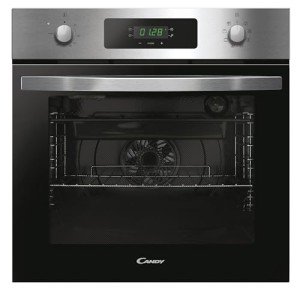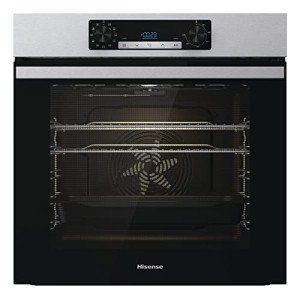 What Is a Single Oven Electric Fan?
What Is a Single Oven Electric Fan?Single oven electric fan is a kind of cooking appliance that uses an internal fan to circulate hot air evenly across the oven cavity. This can help eliminate hot spots and can improve overall cooking results.
Does your oven have fans? If so, does this cause certain areas of the oven hotter or colder than others for a set temperature?
Functions
Oven functions (also called cooking modes or setting) provide a variety of pre-programmed options to cater for many different recipes and cooking needs. These settings determine how the heating elements or the fan within the oven operate which makes it easier to achieve consistent and precise results.
Most ovens are classified as 'fan assisted', which means at the same time as the oven element heats up there is a fan that circulates hot air throughout the oven's cavity, helping in cooking food. This function speeds up the preheating process and provides uniform cooking. In an oven, there are usually two fans: one that distributes hot air to cook and another that cools down the oven. The cooling fan is controlled by a thermoelectric switch. It turns on automatically when the thermostat knob is not set to off.
Functionality for Convenience
Ovens can come equipped with a wide range of features that make them more convenient to use, for instance the defrost mode which uses low temperatures to melt frozen foods without cooking them. This helps speed the process of defrosting and helps prevent dishes from becoming partially cooked or dry. The reheating feature is very useful, as it uses a gentle heating method to heat food. This helps preserve the flavor and texture of the food.
Other helpful features include a child lock function which secures the control panel, preventing children from gaining access or altering the oven's settings. The minute minder feature is another feature that can be used independently of the cooking functions. It switches off the oven when a certain amount of time has been passed. This helps you to avoid forgetting to switch it off.
For those who love cooking a variety of different meals regularly an oven that has multiple functions is ideal. A fan oven with a roast function lets you cook various meats and vegetables simultaneously on multiple racks, making it perfect for Sunday lunches or meals with the family. There are grill and bake options that make great additions to an attractive golden top to casseroles, potatoes and cakes.
Design
electric fan oven single single ovens with built in single oven with grill-in ovens are available in various sizes and styles that will suit your kitchen's requirements. Certain models come with additional features like self-cleaning, delaying start and warm hold. These functions can add up to reduce time and effort in the kitchen. Read reviews to get an idea of how these ovens are rated by other customers.
A fan oven is equipped with a built-in fan that can circulate air around food for quicker, more consistent results than an ordinary oven. This is particularly useful when cooking dishes that have a high fat content like roasts and pies. The control panel will inform you if the oven is a fan model. Look for a three-pronged or fan icon, which is enclosed by an elongated circle. Conventional ovens may be marked differently or not have any fan at all.
This A-rated single electric oven and hob oven from Blomberg boasts a large capacity of 71L and is built under single oven to perform as well as it looks. The oven comes with a variety of options, including grill and fan assisted cookery. It also features an option to turn off the light, making cleaning easy. It also features an adjustable clock/timer that can be programmed with a touch and a simple-to-clean enamel interior.
Energy Efficiency
Ovens are relatively low-energy appliances compared to other appliances in the home like refrigerators and air conditioners. However the type of oven and cooking method used may influence energy costs. Fortunately, a lot of newest single ovens are designed to be more energy efficient than older models. This reduces energy consumption which can lower your energy bill.
The primary distinction between fan ovens and conventional ovens is that a conventional oven has only one heating element, while a 'fan oven' features both a heating element and a blower to circulate hot aer around the food. By using a fan, you can lower the temperature and reduce energy consumption. The fan can also help in reducing the time for baking.
A brushless DC motor is yet another option to ensure that you are getting the most efficient single oven electric fan. This motor technology is more energy efficient than older models that don't have a brushless. It also reduces noise levels.
In addition to the wattage rating, you'll want to pay attention to the energy rating, which should be mentioned on the appliance or in the manual. This number can give you an idea of the amount of energy that is consumed by the oven when in use. You can then compare the cost per kWh to your local electricity rate. This will vary greatly according to where you live.
There are a variety of aspects that affect an oven's overall electricity consumption depending on the nature of the food you cook as well as the temperature setting and the amount of time you cook it for. The cooking process itself can affect how much electricity it consumes in the same way that preheating the oven before using it.
In order to make the most of your oven's energy efficiency, make sure to turn it off after you've finished cooking and monitor your consumption. Smart meters will provide you with accurate information about how much the electricity used by your appliances costs. You can also look into different cooking methods that consume less energy.
Installation
There are costs to consider when replacing or installing an electric fan oven, no matter if it's the first time. These range from getting rid of and medix.in.ua removing the old appliance and installing or upgrading outlets and utilities lines. If the new unit requires vent hoods it is possible to install one. Prices for labor vary among contractors, so you should shop around to find the most affordable price.
It's easy to tell whether your new oven is equipped with a fan since it's likely to be marked as such on the control panel. The fact that it's got a fan means that air circulates continuously inside the oven's chamber, which allows it to get temperature faster and distribute heat evenly. Conventional ovens may have different symbols on the control panel or even no fan icon at all.
You should look at the wiring of the old unit prior to hiring an electrician. If the older one plugs directly into a power socket and is plugged into a power socket, it should be a breeze for a professional to connect it into your wiring system. If the older oven is hardwired to your circuit breaker or switchbox, it will be more difficult. If the new model has more powerful than the older, you'll need to ensure that your circuit breakers are equipped to handle the extra voltage. Also, you'll need to make sure that any cables that are used are large enough.
The cost of installation will vary depending on the location of your kitchen in your home. A freestanding unit that is easily moved from room to room will cost less than a wall-mounted unit that requires cutting into cabinets or counters to install. Additional charges could be incurred if you need to run electric or gas lines or ventilation ductwork.
 If you're replacing an appliance that's already installed, a basic electric fan oven single oven installation isn't going to cost you more than $155 to $70. Installing an exhaust hood, and then installing a new outlet in the kitchen should cost around $300.
📌 20 Trailblazers Are Leading The Way In Single Oven Electric Fan
If you're replacing an appliance that's already installed, a basic electric fan oven single oven installation isn't going to cost you more than $155 to $70. Installing an exhaust hood, and then installing a new outlet in the kitchen should cost around $300.
📌 20 Trailblazers Are Leading The Way In Single Oven Electric Fan

